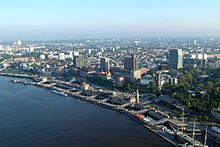Swimming jetty

A floating jetty , also known as a steiger in inland shipping , is a floating jetty on rivers or lakes. A floating jetty consists of a pontoon that can be reached from the mainland via a walkable or drive-on girder as a pier or bridge. Passengers can get to the ship or goods can be loaded and unloaded via jetty / bridge and pontoon. The largest floating jetties in Germany are the St. Pauli Landungsbrücken on the Elbe in Hamburg with several bridges and interconnected pontoons that also support buildings.
Especially on the Rhine , the term ship landing bridge is used for the landing stages of the large passenger ships . The floating jetty that protrudes farthest into the Rhine is the jetty at Namedyer Werth with a length of 135 meters.
With swimming investors are floating docks comparable since they also serve as moorings. With them, however, the jetty itself floats on the water - and usually many boats can moor on a floating jetty at the same time.
construction

The pontoon is on the edge of the fairway . Its position is slidably attached to side posts or stabilized on inland waterways with at least two steel cables or chains stretched at an angle to the bank . In addition, with larger berths (e.g. in the Danube), there are often two hydraulic rods attached at an angle , which are intended to absorb the pressure of the adjacent ships.
There are joints on both abutments of the girder so that the jetty can float up when the water is high and lower when the water is low. At berths for smaller passenger ships, the landside abutment can sometimes be raised or lowered on inclined slide rails in the embankment depending on the water level. At low tide, a staircase between the slide rails is used to connect the jetty and the bank.
Mooring points must be approved by the responsible waterways and shipping authority (WSA). When building a landing stage, all safety-related requirements must be met. The float must be completely closed, contain at least three cells or be foamed with closed pores. The mooring must be provided with safety equipment ( lifebuoy ), railings and barriers . At berths in flowing waters, the float is designed in the shape of a boat.
Special forms
There is a three-part, fold-out floating jetty in the port of Geiranger (Norway). In the fjord two buoys have been anchored between which the up to 300-meter-long cruise ships are firmly clamped. They are there at a distance of about 130 meters from the shore and a water depth of over 20 meters. The Seawalk , which is folded up against the harbor wall, is then unfolded towards the ship and enables passengers to come ashore without tender boats .
Location
While a quay can be built directly on the bank in sufficiently deep waters , there are swimming jetties in the shallower places or in waters with a strong tidal range , but especially on flowing waters such as. B. the Rhine . To ensure a navigable depth, the jetties are between 5 and 15 meters - in exceptional cases even up to 50 meters - in front of the bank on the edge of the shipping channel .
The jetties cannot be used on every type of navigable body of water, because the waves of the sea make installation on most coasts impossible. There are either piers one in the form of the open sea or investors Piers in the international ports used. Both have in common that, in contrast to the swimming jetty, they are firmly anchored and cannot swim.
A jetty with a jetty can also be operated with a cable car if there is a steep incline. Such a system is used on the west side of the Edersee barrier wall . The cable car cabins are used when the footbridge has an inclination angle of more than eight degrees.



